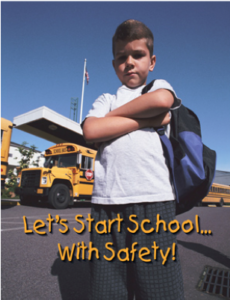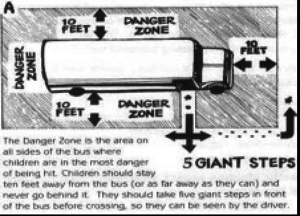 Public Affairs
Public Affairs
USAG Stuttgart
The 2019-2020 school year begins Monday, Aug.26, and while some children will be enrolled in school for the first time, other “veterans” will be looking forward to progressing to the next grade and all the new challenges, teachers and friends that come with it. This is also a crucial time for parents in the Stuttgart military community to think about the well-being of their children and develop strategies to get them back and forth to school safely each day. The following are some tips to make your children’s trips to and from school safe whether they walk, bicycle, ride the school bus or travel by automobile.
Walking
Because of that, it’s particularly important to walk with your child or, when you decide they’re old enough and mature enough to do so safely, allow them to travel with friends. Instruct your child to stay away from parks, vacant lots and other places where they might become isolated and an easy target for a predator.
Carefully research the route your child will travel to school, looking for well-trained adult crossing guards at each intersection. The route should be the most direct one from home to school. Make sure your child understands the importance of obeying all traffic signals and following the instructions of the crossing guards. Also, instruct your child to avoid strangers and never accept rides or engage in conversation with people unknown to your family. Ensure your child wears brightly colored clothing to help motorists see them.
Bicycling
The majority of rules regarding walking also apply to children who ride their bikes to school. Always ensure your child always wears a bicycle helmet that meets U.S. Consumer Product Safety Commission, Snell, American National Standards Institute or American Society for Testing and Materials safety standards. Also, make sure your child’s clothing is appropriate for biking. Avoid ill-fitting clothing that can become tangled in spokes or pedals or inhibit the child’s movement while riding.

Riding the bus
Ensure your child arrives at the bus stop early and instructs them not to play in the street while waiting for the bus to arrive. Your child should understand the importance of waiting for the bus to come to a complete stop before approaching the street. Also, warn them to watch for other vehicles near the bus stop.
Once aboard, children should remain seated at all times and keep their head and arms inside the bus. When exiting, they should use the handrail to avoid falling. Wait for a signal from the bus driver before crossing the street. Walk at least 10 steps away from the front of the bus so the driver can see you. Never cross the street or play behind the school bus. After getting off the bus, move immediately onto the sidewalk and out of traffic. If there is no sidewalk, try to stay as far to the side of the road as possible.
Traveling by automobile
All occupants should have their seat belts securely fastened. Small children should be secured in a car seat that is appropriate for their age and size. Drivers should be careful around children who are walking or riding bicycles to school and comply with the posted speed limit. Remember that children often engage in horseplay and can sometimes run into the road, unaware of the vehicles around them.
Once at home
Another important consideration is protecting children who will be by themselves when they arrive at home each day. The most important ground rules parents need to establish for these children are:
- Establish a check-in time. Once a child arrives home each afternoon, the first thing they should do is phone a parent and let them know they’re at home and everything is OK.
- Security. Children should be instructed to keep doors shut and locked at all times. They should also be given clear guidelines of what they can and can’t do. For example, children should not try to use the stove, as they can be burned or start a fire.
A final consideration is for those children wearing backpacks to school. Recent studies show that backpacks are often overloaded, causing an unnatural compression of the spine as the child compensates for the weight by bending forward or walking with an arched back. This can result in injuries that can last a lifetime. A solution is to limit items in the backpack to only those necessary for class work. Additionally, items placed in the backpack should be evenly distributed, and the backpack should be equipped with features such as padded straps. Some backpacks are now equipped with wheels and towing handles for convenience.
School should be a fun and exciting time for children. Following these tips and precautions will help make it a safe time as well.
